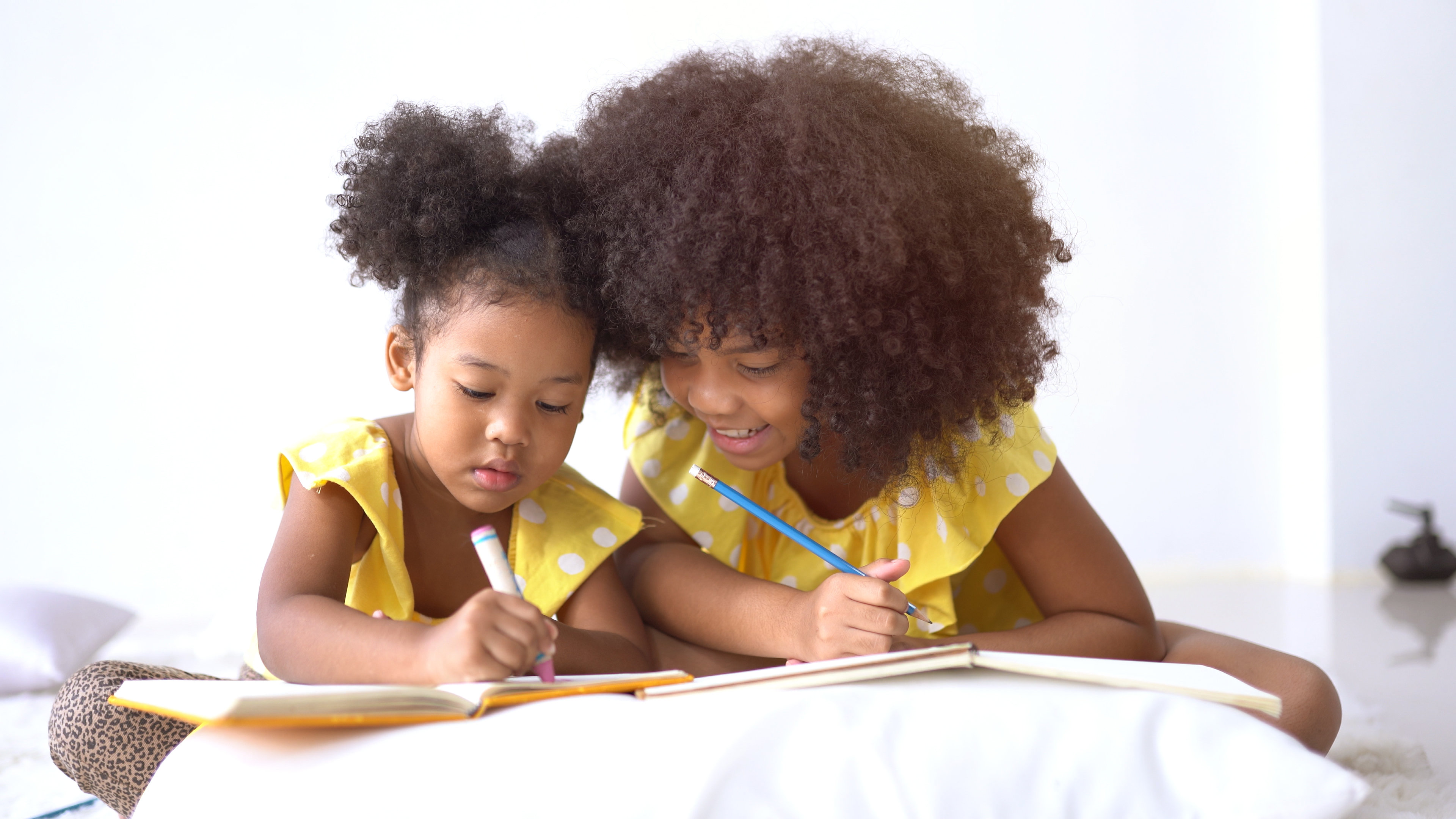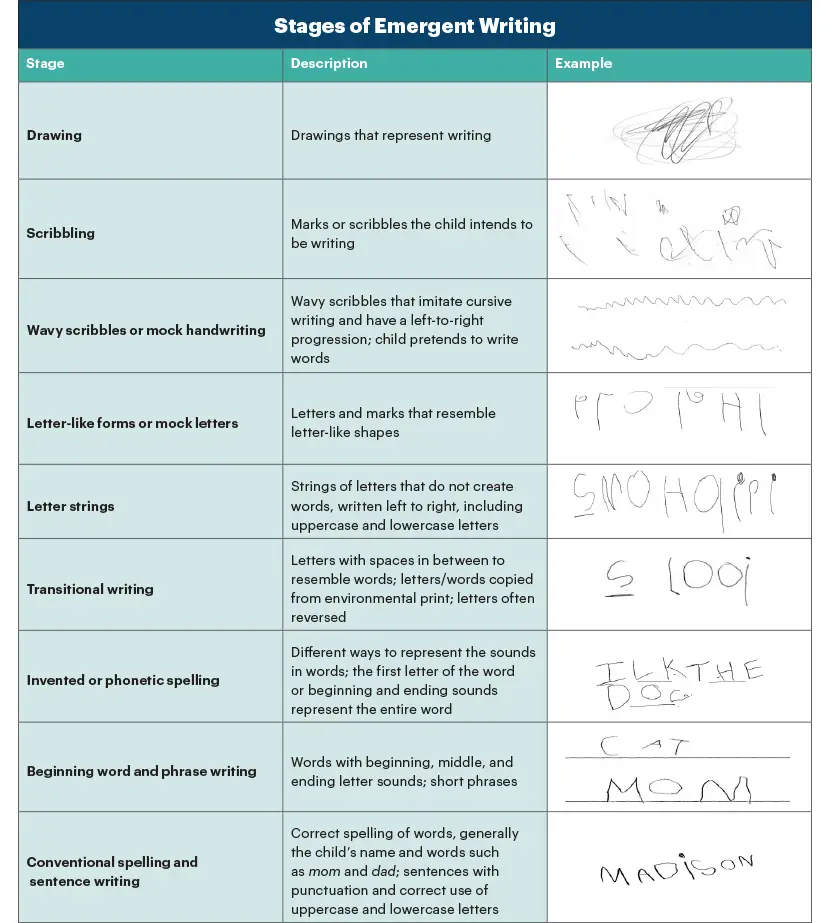Writing is one of the many skills children practice in their early years and provides many fantastic opportunities for growth and skill-building. Most kids learn pre-writing skills around ages 3 and 4 and want to practice a specific skill until they have mastered motor control.
Writing is critical to development because it improves self-esteem, literacy, and communication skills. Children learn to handle problems creatively and read because writing reinforces language and art skills.
In this post, I want to discuss the importance and benefits of early writing skills and describe how children learn to write. There are ways to make writing more fun! You can encourage children to write in early childhood, and understanding ways to improve their skills will help you and your kids with their pre-writing skills!

What Are Early Writing Skills?
Early writing skills or pre-writing skills are the fine motor skills that children must develop before writing correctly. Developing the small muscles in the hands helps children hold writing tools like markers and crayons.
Early writing skills focus on the child’s hand and eye development, and children practice them throughout the day. They teach the child ways to hold a pencil, trace, color, and cut.
Fine motor skills in early childhood development allow kids to practice and strengthen parts of the body that need to feel comfortable with moving writing materials, grasping tools, and maintaining hand-eye coordination.
Fine motor development develops and strengthens the movement between the small muscles in children’s fingers, hands, and arms.
Here are body parts and skills children must develop to write well.
- hand strength
- finger strength
- hand-eye coordination
- pincer grasp
- upper body strength
- visual perception
- hand dominance
Writing Development Early Childhood
According to this website, there are four stages of writing development in early childhood; preliterate, emergent, transitional, and fluent.
Preliterate
Also called scribbling, preliterate writing is when children tend to realize they have this magical hand power. They want to use their hands on anything they can think of to practice movement and coordination. Scribbling can look like random shapes, blocks of harsh lines, and maybe some letters.
Children learn they can pretend to act like an adult, so they get pads of paper (or perhaps a wall) and mimic the adults in their lives. I will always cherish my son’s small paper scrolls when he was pretending he was a pirate and the notebook my daughter created when she was taking my food order.
Emergent
Emergent writing does look a bit more elaborate as children attempt to recreate various written patterns. It is a bit more complicated than scribbles. Instead of crazy shapes and wonky lines, emergent writing appears more like stripes of text, swirls, and noticeable letters.
There are stages to emergent writing that involve imitative writing, copying certain words, and drawing long lines that look like sentences. Early learners might look for cereal boxes to copy or use picture books with large text to follow language patterns and draw familiar signs, people, and animals.
Transitional
Consider the word transition; now think of a child in this stage. Transitional writing involves the children going from the previous step into the next development phase. Around age 4, children’s writing changes from random letters, lines, and squiggles, to words that mean something to them.
Transitional writing likely is imperfect –like, duh– because they are kids, but they are so proud! Their words create meaning, and they have tons of potential. Kids learn to match sounds together to write what they hear in their minds. Small words kids practice are probably small and relatable to their current environment– dog, ball, oatmeal.
Fluent
By the time kids master hand-eye coordination and value accuracy, they have made it to the fluent state of writing. They understand how to create writing goals and challenge themselves to write quickly, and learn to identify their mistakes for next time.
Eventually, children who are fluent in writing string together many words and use age-appropriate or preferential tools which encourages mastery. They might start learning different parts of speech and copy the elaborate text in books to practice. They likely have access to activity books and want to create the sentences the books have provided for practice.

Early Writing According to NAEYC
The National Association For the Education of Young Children, NAEYC, says there are many steps for emergent writers. Kids as young as two repeat writing patterns to create letters and match sounds with shapes and activities.
Children learn to write by imagining, repeating, practicing their skills, and applying them to daily life. Kids follow different patterns to achieve a goal or see a particular outcome of their writing. When given space, tools, and opportunities to strengthen hand muscles, they learn and practice these steps.
They might like writing letters to friends in school or chalk art on the sidewalk. These writing steps may happen in different ways for different temperaments and abilities. Writing development is likely more spread out in these stages than preliterate, emergent, transitional, and fluent. There are various skills and muscles to develop before fluency is achieved. NAEYC’s writing stages consider more specific actions that develop due to a particular age, materials, and mastery of previous skills.
Here are the stages of writing development according to NAEYC.
- Drawing
- Scribbling
- Wavy scribbles
- Mock letters
- Letter strings
- Traditional writing
- Invented spelling
- Beginning word and phrase writing
- Convention spelling
How to Encourage Writing in Early Years
Some children are naturally drawn to writing and have no problems conquering their fears. Others who are more hesitant may need some assistance. There are many ways to encourage writing skills in your home and even outside.
Teach children to write by offering age-appropriate tools and suggestions that are low on the ground. Provide opportunities for children to witness you practicing these skills, try to make it fun, simple, and stress-free.
Stay curious, creative, and communicative to learn different ways to promote writing in your personal space. Figure out your child’s true interests to teach them that writing is practical when applied to a skill, task, or activity they have already mastered.
Here are some ways to improve early writing skills.
- Use appropriate tools
- Make it fun
- Make it relatable
- Stay emotionally regulated
- Take a break
- Try different things
Use Appropriate Tools For Writing
Younger children start with large-sized crayons or jumbo markers as they learn to pinch and grasp. Toddlers and younger kids practice with these tools for years before they learn to hold small pencils and markers.
Provide opportunities for kids to write– large paper, whiteboards, tracing paper, sidewalk chalk. This ensures they have access to multiple kinds of materials in different settings when they feel energized to practice writing skills.
Make Writing Fun
Make it fun and silly to show them different ways to write and trace. Try writing in the sand and steam on bathroom windows. Trace in sensory materials like slimes or dough and use stencils with giant letters to cut out playdoh words.
Try using different materials and objects like car windows when frosty outside. Consider huge paper rolls that can be lengthened across the carpet to reinforce story-telling or practice large format printing.
Show or model your own writing skills. Model writing skills with your child to allow them to witness this skill done in real life and see the purpose and value of writing. When they are curious, consider inviting them into your space to show them how you use your skills to do things like write grocery lists and pay bills.
Make It Relatable
Encourage them to use their skills to practice communicating with others as they learn and grow alongside other kids and adults in their personal settings. Send cards to friends, write on birthday cakes with frosting and use small opportunities for connection to practice writing.
Help them understand that writing is a way to talk to others through symbols and shapes until it is time to learn more advanced writing skills like writing letters, stories, or poems.
My son loved making signs; he made signs for our dog’s food dish, Santa signs, and welcome home banners. Whatever your child is into –TV shows, animals, trucks, books– incorporate those things into their writing practice. They might want to write letters to Ryder or Chase or Pinky Pie! LOL 🤣
Stay Emotionally Regulated
Try to be emotionally regulated and stay calm when children express intense frustration. Kids learning this skill want to feel safe with their intense feelings and emotions when they fail to express themselves through writing and story-telling.
Continue to be curious as they improve language development and motors skills, so they don’t surrender to their feelings but understand that it takes time, commitment, and consistency.
Let them express feelings of self-doubt to harness their big feelings of control. Turn their feelings of uncertainty into pride and worth by allowing their emotions to rise and fall like a crashing wave.
Try to understand what is stopping them from providing opportunities to practice that exact skill or communication technique.
Sometimes children create boundaries for fear of failure. Approach this wall as an opportunity to teach them about the fear that is stopping them from excelling.
Children may need to communicate a spatial issue with a younger sibling or frustration with a tool that keeps breaking. Sometimes, parents stop them, and they don’t understand why.
Continue to coach children into a space that feels safe instead of a space of resentment to help them learn about their reality instead of feeling frightened to experience failure.
Take a Break
Sometimes, parents are overwhelmed with responsibilities and forget to slow down and enjoy the company of their children. Try to play with them!
Listen, I know it is hard. Just keep trying; here is an article I wrote about playing with kids.
Balance the rest of your responsibilities so you have the time to sit and play with writing tools together. Take time out of your schedule to devote to learning and show kids that you can stay connected through new experiences and skill-building.
Spend time learning about them and play with them to show them you value closeness. Understanding your child is a critical part of teaching them because you know different methods of teaching when you consider the ways they learn skills.
Try Different Things
Kids learn many skills in totally different ways. Consider different angles to teaching kids to write when exposing yourself to their temperaments and personality traits. Some kids like using challenge-based opportunities like races, strategy games, and competitions. Other kids might enjoy soft waxy egg crayons or silky scarfs to draw letters in the air.
Kids have unique personal interests and needs. Develop new strategies to get into their heads so you understand their interests and grow our ideas from there. The more kids feel heard and understood, the more likely they are to try new things because they know that they are valued.
Consider purchasing different online classes, online tools, or physical tools that will help your child improve writing skills. There are fun outdoor opportunities like chalk art and mud that might be their vibe if they are sensory kids. Technologically capable kids might appreciate a pretend keyboard or a tablet.
Benefits of Writing For Preschoolers
Writing helps children develop because they value personal expression and practice communication. Early on, kids want to learn simple concepts like their name, address, phone number, and family members’ names. Writing helps kids analyze spelling, develop fluent reading skills, and master skills.
Here are some other benefits of writing for young children.
- kids develop new ideas
- young children practice mindfulness
- Kids reflect through writing
- It is a creative outlet for children
- Kids use it to express themselves
- They learn to manage personal thoughts
- Kids master hand-eye coordination
- Muscles develop during writing
- Writing teaches children about literature
- It develops concentration
- Writing reinforces different language forms– newspapers, magazines, books
Final Thoughts
You are doing it hard; I can tell! Early writing or pre-writing skills develop strength, coordination, and self-esteem. Writing should be a fun experience for kids, or they will shy away. There are ways to encourage early writing skills; using to proper tools and having the time. These memories will stay with them for a lifetime. Keep it up, parents!
Sources
- 11 Tips for Playing With Children– adult-led, child-led – Mission Momplex
- Promoting Preschoolers’ Emergent Writing | NAEYC
- Stages of Emergent Writing | Thoughtful Learning K-12
- Temperaments– Children, What they are, Importance – Mission Momplex
- The stages of writing development and how to teach your child to write. Find out what writing skills your child will learn and when they happen. Get easy suggestions on helping your child stay on track and learn to write. | BabyCenter
- Typical Language Accomplishments for Children, Birth to Age 6 — Helping Your Child Become a Reader (ed.gov)
- Writing Readiness (Pre-Writing) Skills – Kid Sense Child Development
